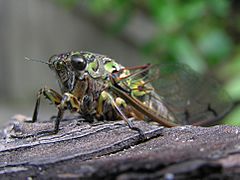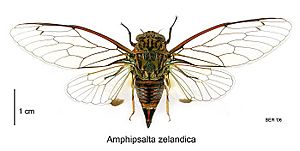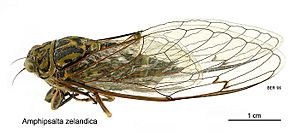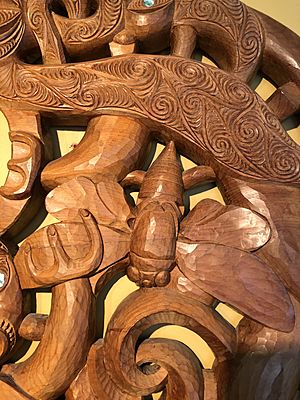Chorus cicada facts for kids
Quick facts for kids Chorus cicada |
|
|---|---|
 |
|
| A chorus cicada, Amphipsalta zelandica | |
| Scientific classification | |
| Kingdom: | |
| Phylum: | |
| Class: | |
| Order: | |
| Suborder: |
Auchenorrhyncha
|
| Infraorder: |
Cicadomorpha
|
| Superfamily: | |
| Family: |
Cicadidae
|
| Genus: |
Amphipsalta
|
| Species: |
A. zelandica
|
| Binomial name | |
| Amphipsalta zelandica (Boisduval, 1835)
|
|
| Synonyms | |
|
|
The chorus cicada is the most common type of cicada in New Zealand. It is found only there, which means it is endemic. You can spot them in most parts of the country. These insects usually live in forests and open bush areas. During summer, you might see their old skin on tree trunks and branches. Male cicadas make a very loud sound together. This sound can be deafening when there are many cicadas, especially around February. Sometimes, groups of cicadas will suddenly stop singing. Instead, they make clicking sounds by clapping their wings against the surface they are sitting on.
Contents
What Does a Chorus Cicada Look Like?
Chorus cicadas start as a nymph before becoming an adult. Nymphs are soft and creamy white. They look a lot like adult cicadas, but they do not have wings. Adult cicadas are usually more than 2 cm long. The biggest ones can be up to 4 cm long, including their wings.
Cicadas only get their wings after they molt into adults. Their wings are thin and clear, with visible veins. These wings can even block out ultraviolet light. The wingspan of a chorus cicada is about 6 cm.
Chorus cicadas can be black, green, or brown. Many have stripes along their bodies. Their antennae have seven parts. The last part is narrower in the middle. Male cicadas have a special part called a clasper sheath. Females do not have the finger-like parts that males have.
The sound made by cicadas is the loudest noise made by any insect. Male chorus cicadas make a special song to communicate. Each cicada species has its own unique song. This means you can tell different species apart by their sounds. Their song is made of groups of five clicks. The middle click is stronger than the two clicks on either side. If a cicada is tired, the middle click might sound like two clicks instead of one. They make these clicks by hitting their wings against the surface they are on. These clicks can be made very fast and continuously during chorus singing. Chorus cicadas are New Zealand's largest cicadas. They average about 40 mm in size.
What Do Cicadas Eat?
Both adult and young chorus cicadas (nymphs) drink xylem sap from plants. This sap is low in nutrients and doesn't have all the amino acids they need. To get missing nutrients, cicadas rely on tiny bacteria living inside them. These bacteria help provide the missing food. Because they can feed on many different plants, chorus cicadas are called generalist feeders. The roots of orchard trees are a good food source for nymphs living in the soil.
Where Do Chorus Cicadas Live?
Global Home
Chorus cicadas are insects that are only found in New Zealand. This means they are endemic to this country. Their closest relatives live in Australia, New Caledonia, and Norfolk Island. Some studies suggest that New Zealand's insects came from several trips across the Tasman Sea from Australia or New Caledonia.
New Zealand Home
Chorus cicadas are often seen in towns and cities. They live all over New Zealand. They are common in the North Island, some coastal areas of the South Island, central Otago, and parts of Canterbury.
Favorite Places to Live
Chorus cicadas are usually found in open forests and woodlands. But sometimes, you might see them on buildings, fences, or lamp posts. Cicadas prefer warm, humid, and mild environments.
Cultural Importance
The Māori names for cicadas are kihikihi wawa, matua kihikihi, or ngengeti. There is a famous Māori haka (a ceremonial dance or challenge) and folk song called Te Tarakihi. This song is based on the loud summer singing of the cicada.
Life Cycle of a Chorus Cicada
Male cicadas sing to attract females. This singing helps many males and females gather together. Males try to sing the loudest and best to compete with each other. They sing even louder when the weather is warmer. Sometimes, two cicadas might even fight. Chorus cicadas usually mate quietly on a tree trunk.
Adult cicadas have a short life, lasting only two to three weeks. After mating, the adult cicadas die. Female chorus cicadas lay their eggs in thin branches of many different plants. A female can lay from 5 to 700 eggs. Each egg is about the size of a grain of rice. They lay their eggs in a zig-zag pattern inside the thin tree branches.
The eggs take 3 to 10 months to hatch. Hatching happens from May to mid-December. After hatching, the young larvae dig into the ground. There, they grow and develop their body parts. They also get bigger. This change into nymphs happens during the spring and winter months. During this time, the nymphs feed on the juices from plant roots and other things underground. The nymph stage can last from 25 to 44 months.
Once the nymphs have grown as big as they can, they come out of the ground. They climb up tree trunks to molt. This is when they change from nymphs into adult cicadas. This happens on summer nights, from mid-December to late February. After they shed their last nymph skin, their wings expand. They wait for their wings to get hard before they can fly away.
The total life cycle of a chorus cicada is about four years. This includes everything from the egg stage to the natural death of the adult.
Who Hunts Cicadas?
Chorus cicadas have several animals that hunt them. However, they have few known parasites. When they are adults, cicadas can be eaten by wasps (like the Vespula vulgaris), birds, and spiders. They can also get fungal diseases. When they are nymphs, beetles and fungal diseases can kill them. Some parasitic wasps lay their eggs inside the cicada's eggs.







